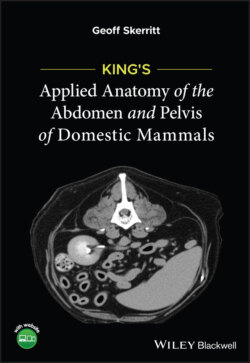Читать книгу King's Applied Anatomy of the Abdomen and Pelvis of Domestic Mammals - Geoff Skerritt - Страница 18
1.3.1 The skin
ОглавлениеThe skin, or common integument, varies in thickness between species and bodily location. The abdominal skin is very thick (4–5 mm) in the ox but is quite delicate and thin (1–3 mm) in the other domestic species. Hair grows from the skin in all of the species but is much less in the pig. In all species there is much less hair on the ventral abdomen than elsewhere. Most of the hair of the sheep has a specific structure and is termed wool. In all species except the pig a principal function of the hair/wool is to reduce heat loss; the pig relies on a large amount of subcutaneous fat for this function.
The domestic species vary in regard to the number and distribution of the mammary glands. The mare has only two mammary glands, and these are located either side of the midline on the ventral abdomen in a prepubic position. The cow usually has four mammary glands, collectively known as the udder; it is located mainly ventral to the caudal abdomen but with its caudal part ventral to the pelvis. The udder is suspended by strong elastic tissue extending essentially from the linea alba and the symphyseal tendon.
There are seven pairs of mammary glands in the sow, although only 8–10 are usually functional depending on litter size. In this species the mammary tissue extends in the body wall from the axilla to the level of the stifle.
The udder of small ruminants comprises two glands and is situated in the inguinal region. In the bitch there are usually five pairs of mammary glands; in the cat there are generally four pairs.
